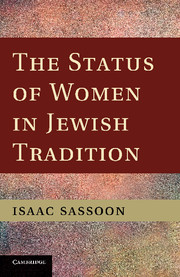Book contents
- Frontmatter
- Contents
- Preface
- Acknowledgements
- Glossary
- Abbreviations
- PART I MONOGAMY
- 1 The Sources
- 2 Pro-CD Arguments
- 3 Anti-CD Arguments
- 4 Indeterminate Arguments
- 5 Make-or-Break Argument
- 6 Which Way Does the Evidence Point?
- 7 Gen 1:27–29 Revisited
- PART II COMMANDMENTS (MIṢVOT)
- PART III INTRINSIC EQUALITY
- Conclusion
- Bibliography
- Index of Authors (Medieval & Pre-modern)
- Index of Citations from Rabbinic Literature
- Index of Names (Hebrew Bible)
- Index of Names (Talmudic)
- General Index
6 - Which Way Does the Evidence Point?
Published online by Cambridge University Press: 01 June 2011
- Frontmatter
- Contents
- Preface
- Acknowledgements
- Glossary
- Abbreviations
- PART I MONOGAMY
- 1 The Sources
- 2 Pro-CD Arguments
- 3 Anti-CD Arguments
- 4 Indeterminate Arguments
- 5 Make-or-Break Argument
- 6 Which Way Does the Evidence Point?
- 7 Gen 1:27–29 Revisited
- PART II COMMANDMENTS (MIṢVOT)
- PART III INTRINSIC EQUALITY
- Conclusion
- Bibliography
- Index of Authors (Medieval & Pre-modern)
- Index of Citations from Rabbinic Literature
- Index of Names (Hebrew Bible)
- Index of Names (Talmudic)
- General Index
Summary
Having thus cleared the be-ḥayyehah hurdle, we submit that CD's understanding of Lev 18:18 wins on balance, if by a whisker. Even so, the wrangle rages on, as documented by Jacob Milgrom:
a woman … to her sister wĕ'iššậ ‘el-'ăḥōtāh. The preposition 'el bears the meaning “with, in addition to.” Note the same phrase 'iššậ ‘el-'ăḥōtāh ‘one to the other’ (Exod 26:3), referring to the tabernacle curtains (cf. Jos 13:22; m. Yev. 11:1). The meaning of the prohibition has been subject to vigorous (and vitriolic) debate:
1. The Karaites (in view of analogous wording in Exod 26:3) render 'ăḥōtāh not as “her sister,” but as “another (woman).” Then, rendering liṣrậr metaphorically as “to inflict pain, misery” on the basis of its primary meaning “to bind” (cf. 2Sam 20:3), they interpret the verse as prohibiting polygamy only if the husband deprives his wives of their conjugal rights (Seper Ha-Mibḥar, Keter Torah)…
2. The sectaries of Qumran maintain the opposite view. They, too, read 'ăḥōtāh as 'iššậ 'aḥeret ‘another woman’…
3. The prohibition bans marriage to a sister-in-law during the lifetime of the wife (Philo, Laws 3.27; m Qid. 2:7).
If the dialectic hitherto has been all tree, here comes the forest. Averting our microscopic lens from Lev 18:18, we need to stand back and consider the overall plausibility of P banning polygyny. P makes no bones about the weight it attaches to human propagation (see Gen 1:28; 8:1, 7; 35:11; Lev 26:9).
- Type
- Chapter
- Information
- The Status of Women in Jewish Tradition , pp. 31 - 34Publisher: Cambridge University PressPrint publication year: 2011



